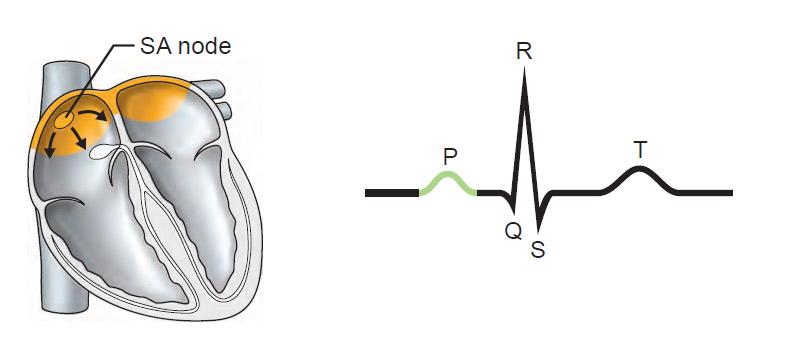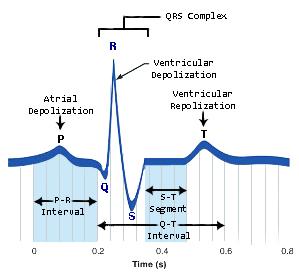Instructions for Side by Side Printing
- Print the notecards
- Fold each page in half along the solid vertical line
- Cut out the notecards by cutting along each horizontal dotted line
- Optional: Glue, tape or staple the ends of each notecard together
Review Questions - The Cardiovascular System the Heart
front 1 When the semilunar valves are open, which of the following are occurring?
| back 1 A)2, 3, 5, 6 |
front 2 The portion of the intrinsic conduction system located in the superior interventricular septum is the
| back 2 C)AV bundle |
front 3 An ECG provides information about
| back 3 B)Movement of the excitation wave across the heart |
front 4 The sequence of contraction of the heart chamber is
| back 4 C)Both atria followed by both ventricles |
front 5 The fact that the left ventricle wall is thicker than the right reveals that
| back 5 B)Pumps blood against greater resistance |
front 6 The chordae tendinease
| back 6 B)Prevents the AV valve flaps from everting |
front 7 In the heart, which of the following apply?
| back 7 C)1, 2, 3, |
front 8 The activity of the heart depends on intrinsic properties of cardiac muscle and on neural factors. Thus,
| back 8 D)all of the above. |
front 9 Freshly oxygenated blood is first received by the
| back 9 B)left atrium, |
front 10  | back 10 Atrial depolarization, initiated by the SA node, causes the P wave. |
front 11 Describe the location and position of the heart in the body. | back 11 The heart is enclosed within the mediastinum. It lies anterior to the vertebral column and posterior to the sternum. It tips slightly to the left. |
front 12 Describe the pericardium and distinguish between the fibrous and the serous pericardia relative to histological structure and function | back 12 The pericardium has two layers, a fibrous and a serous layer. The outer fibrous layer is a fibrous connective tissue that protects the heart and anchors it to surrounding structures. The inner serous layer (squamous epithelial cells) lines the fibrous layer as the parietal serous pericardium and at the base of the heart continues over the heart surface as the visceral serous pericardium. The visceral serous pericardium is the outermost layer of the heart wall, that is, the epicardium. |
front 13 Trace one drop of blood from the time it enters the right atrium until it enters the left atrium. What is the circuit called? | back 13 •Pulmonary circuit
|
front 14 (a)Describe how the heart contraction and relaxation influences coronary blood flow
| back 14 a. When the ventricles begin to relax following contraction, blood flows back toward the ventricles, getting caught in the semilunar valves. During this time, the coronary arteries are actively delivering blood to the myocardium. During ventricular contraction, the coronary vessels are compressed and ineffective in blood delivery. (pp. 667, 670)
|
front 15 The refractory period of cardiac muscle is much longer than that of skeletal muscle. Why is a desirable functional property? | back 15 A longer refractory period of cardiac muscle is desirable because it prevents the heart from going into prolonged or tetanic contractions, which would stop its pumping action. (p. 673) |
front 16 (a)What are the elements of the intrinsic conduction system in order beginning with pacemaker?
| back 16 a. The elements of the intrinsic conduction system of the heart, beginning with the pacemaker, are: the SA node or pacemaker, AV node, AV bundle, right and left bundle branches, and the subendocardial conducting network. (pp. 675–676)
|
front 17 Draw a normal ECG pattern. Label and explain the significance of its waves. | back 17  The P wave results from impulse conduction from the SA node through the atria during atrial depolarization. The QRS complex results from ventricular depolarization and precedes ventricular contraction. Its shape reveals the different size of the two ventricles and the time required for each to depolarize. The T wave is caused by ventricular repolarization. (pp. 677–678) |
front 18 Define cardiac cycle, and follow the events of one cycle. | back 18 The cardiac cycle includes all events associated with the flow of blood through the heart during one complete heartbeat. One cycle includes a period of ventricular filling (mid-to-late diastole at the end of which atrial systole occurs), isovolumetric contraction (early ventricular systole), ventricular ejection (mid to late ventricular systole), and isovolumetric relaxation (early ventricular diastole). (pp. 679–680) |
front 19 What is cardiac output, and how is it calculated? | back 19 Cardiac output is the amount of blood pumped out by the left ventricle in one minute. It can be calculated by the following equation: cardiac output = heart rate × stroke volume. (p. 681) |
front 20 Discuss how Frank-Starling law of the heart helps to explain the influence of venous return on stroke volume | back 20 The Frank-Starling law explains that the critical factor controlling stroke volume is the degree of stretch of the cardiac muscle cells just before they contract. The important factor in the stretching of cardiac muscle is the amount of blood returning to the heart and distension of the ventricles. (p. 682) |
front 21 Describe the common function of the foramen ovale and the ductus arteriosus in a fetus.
| back 21 a. In a fetus, the common function of the foramen ovale and the ductus arteriosus is to allow blood to bypass the pulmonary circulation, and move directly into the systemic circulation.
|
front 22 Critical Thinking
| back 22 Cardiac tamponade is the compression of the heart that occurs when blood or fluid builds up in the space between the myocardium (the muscle of the heart) and the pericardium (the outer covering sac of the heart) (p. 661) |
front 23 Critical Thinking
| back 23 a. To auscultate the aortic valve, place the stethoscope over the second intercostal space at the right sternal margin. To auscultate the mitral valve, place the stethoscope over the heart apex, in the fifth intercostal space in line with the middle of the clavicle. (p. 679)
|
front 24 Critical Thinking
| back 24 Failure of the left ventricle (which pumps blood to the body) can result in chest pain due to dying or dead ischemic cardiac cells; pale, cold skin due to lack of circulation of blood from blocked ventricular contraction; and moist sounds in the lower lungs due to high pressure and pooling of blood in the pulmonary circulation because of nonfunction of the left ventricle. (pp. 668–669) |
front 25 Critical Thinking
| back 25 Oxygen-deficient blood returning from the systemic circulation to the right heart will pass repeatedly around the systemic circuit, while oxygenated blood returned from the lungs is continually recycled through the pulmonary circuit. (pp. 686–687) |
front 26 Critical Thinking
| back 26 Gabriel, being a user of an injectable drug, probably was infected by a bacteria-contaminated (“dirty”) needle used to administer heroin. (p. 690) |